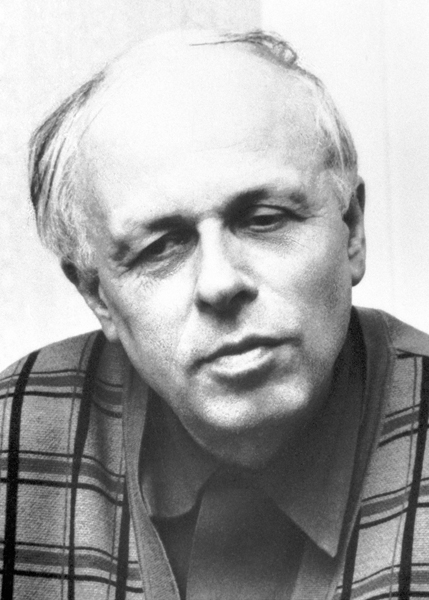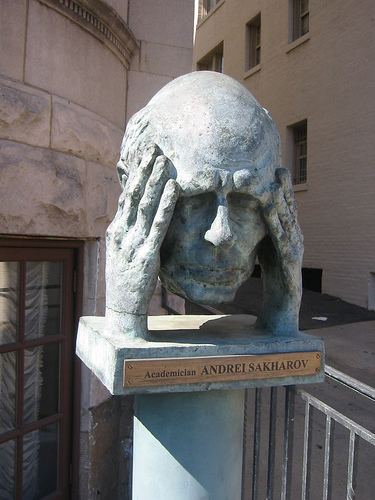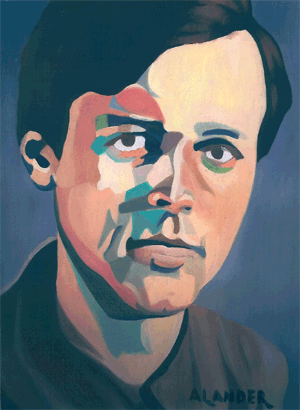<Back to Index>
- Physicist Andrei Dimitrievich Sakharov, 1921
- Painter Albrecht Dürer, 1471
- King of Spain Philip II, 1527



Andrei Dmitrievich Sakharov (Russian: Андре́й Дми́триевич Са́харов; May 21, 1921 – December 14, 1989) was an eminent Soviet nuclear physicist, dissident and human rights activist. Sakharov was an advocate of civil liberties and reforms in the Soviet Union. He was awarded the Nobel Peace Prize in 1975.
Sakharov was born in Moscow on May 21, 1921. His father was Dmitri Ivanovich Sakharov, a private school physics teacher and an amateur pianist. Dmitri's grandfather Ivan had been a prominent lawyer in Tsarist Russia who had displayed respect for social awareness and humanist principles (including advocating the abolition of capital punishment) that would later influence his grandson. Sakharov's mother was Yekaterina Alekseyevna Sakharova (née Sofiano and of Greek ancestry). His parents and his paternal grandmother, Maria Petrovna, largely shaped Sakharov's personality. Although his paternal great-grandfather had been a priest in the Russian Orthodox Church, and his pious mother did have him baptised, his father was an atheist and religion did not play an important role in his life, though he did believe that a non-scientific "guiding principle" governed the universe and human life. Sakharov entered Moscow State University in 1938. Following evacuation in 1941 during the Great Patriotic War (World War II), he graduated in Aşgabat, in today's Turkmenistan. He was then assigned laboratory work in Ulyanovsk. During this period, in 1943, he married Klavdia Alekseyevna Vikhireva, with whom he raised two daughters and a son before she died in 1969. He returned to Moscow in 1945 to study at the Theoretical Department of FIAN (the Physical Institute of the Soviet Academy of Sciences). He received his Ph.D. in 1947.
On World War II's end, Sakharov researched cosmic rays. In mid-1948 he participated in the Soviet atomic bomb project under Igor Kurchatov. The first Soviet atomic device was tested on August 29, 1949. After moving to Sarov in 1950, Sakharov played a key role in the next stage, the development of the hydrogen bomb. The first Soviet fusion device was tested on August 12, 1953, using what was called the Sloika design. In 1953, he received his D.Sc. degree, was elected a full member of the Soviet Academy of Sciences, and was awarded the first of his three Hero of Socialist Labor titles. Sakharov continued to work at Sarov, playing a key role in the development of the first megaton-range Soviet hydrogen bomb using a design known as "Sakharov's Third Idea" in Russia and the Teller-Ulam design in the United States. It was first tested as RDS-37 in 1955. A larger variation of the same design which Sakharov worked on was the 50MT Tsar Bomba of October 1961, which was the most powerful device ever exploded. In 1950 he also proposed an idea for a controlled nuclear fusion reactor, the tokamak, which is still the basis for the majority of work in the area. Sakharov, in association with Igor Tamm, proposed confining extremely hot ionized plasma by torus shaped magnetic fields for controlling thermonuclear fusion that led to the development of the tokamak device. In 1951 he invented and tested the first explosively pumped flux compression generators, compressing magnetic fields by explosives. He called these devices MC or MK (for magnetocumulative) generators. The radial MK-1 produced a pulsed magnetic field of 25 megagauss (2500 teslas). The following helical MK-2 generated 100 million amperes in 1953. Sakharov then tested a MK-driven "plasma cannon" where a little aluminium ring was vaporized due to the huge eddy currents into a stable, self-confined toroidal plasmoid and was accelerated to 100 km/s. Sakharov later suggested to replace the copper coil in MK generators by a big superconductor solenoid to magnetically compress and focus underground nuclear explosions into a shaped charge effect. He theorized this could focus 1023 protons per second on a 1 mm2 surface, then envisaged to make two such beams collide. But it is not known if any experiment based on this idea has been ever achieved.
After 1965 Sakharov returned to fundamental science and began working on particle physics and cosmology. He especially tried to explain the baryon asymmetry of the universe, being the first scientist to introduce two universes called "sheets", linked by the Big Bang. Sakharov achieved there a complete CPT symmetry since the second sheet is enantiomorph (P-symmetry), has an opposite arrow of time (T-symmetry) and is mainly populated by antimatter (C-symmetry) because of an opposite CP-violation. In this model the two universes do not interact, except via local matter accumulation whose density and pressure would become high enough to connect the two sheets through a bridge without spacetime between them, but with geodesics continuity beyond the radius limit allowing an exchange of matter. Sakharov called such singularities a collapse and an anticollapse, which are an alternative to the couple black hole and white hole in the wormhole theory. Sakharov also proposed the idea of induced gravity as an alternative theory of quantum gravity. From
the late 1950s Sakharov had become concerned about the moral and
political implications of his work. Politically active during the
1960s, Sakharov was against nuclear proliferation. Pushing for the end of atmospheric tests, he played a role in the 1963 Partial Test Ban Treaty, signed in Moscow. In 1965 he returned to fundamental science and began working on cosmology. The major turn in Sakharov’s political evolution started in 1967, when anti-ballistic missile defense
became a key issue in US–Soviet relations. In a secret detailed letter
to the Soviet leadership of July 21, 1967, Sakharov explains the need
to "take the Americans at their word" and accept their proposal
"for a bilateral rejection by the USA and the Soviet Union of the
development of antiballistic missile defense", because otherwise an
arms race in this new technology would increase the likelihood of
nuclear war. He also asked permission to publish his manuscript (which
accompanied the letter) in a newspaper to explain the dangers posed by
this kind of defense. The government ignored his letter and refused to
let him initiate a public discussion of ABM in the Soviet press. In May 1968 he completed an essay, Reflections on Progress, Peaceful Coexistence, and Intellectual Freedom,
where the anti-ballistic missile defense is featured as a major threat
of world nuclear war. After this essay was circulated in samizdat and
then published outside the Soviet Union, Sakharov was banned from all
military-related research and Sakharov returned to FIAN to study
fundamental theoretical physics. In 1970 he, along with Valery Chalidze and Andrei Tverdokhlebov, was one of the founders of the Moscow Human Rights Committee and came under increasing pressure from the government. He married a fellow human rights activist, Yelena Bonner, in 1972. In 1973 he was nominated for the Nobel Peace Prize and in 1974 was awarded the Prix mondial Cino Del Duca.
He was awarded the Nobel Peace Prize in 1975, although he was not
allowed to leave the Soviet Union to collect it. His wife read his
speech at the ceremony in Oslo, Norway. Sakharov's
ideas on social development led him to put forward the principle of
human rights as a new basis of all politics. In his works he declared
that "the principle 'what is not prohibited is allowed' should be
understood literally", denying the importance and validity of all rules
and regulations not codified in the laws. He was arrested on January
22, 1980, following his public protests against the Soviet Invasion of Afghanistan in 1979 and was sent to internal exile in the city of Gorky, now Nizhny Novgorod, a closed city that was inaccessible to foreign observers. Between
1980 to 1986, Sakharov was kept under tight Soviet police surveillance.
In his memoirs he mentions that their apartment in Gorky was repeatedly
subjected to searches and heists. He remained isolated but unrepentant
until December 1986 when he was allowed to return to Moscow as Mikhail Gorbachev initiated the policies of perestroika and glasnost. There, in secret, he met and worked with Western scientists such as Eric Fawcett. Sakharov was named the 1980 Humanist of the Year by the American Humanist Association. Later, in 1988, Sakharov was given the International Humanist Award by the International Humanist and Ethical Union. He
helped to initiate the first independent legal political organizations
and became prominent in the Soviet Union's growing political
opposition. In March 1989, Sakharov was elected to the new parliament,
the All-Union Congress of People's Deputies and co-led the democratic opposition.
Soon
after 9:00 pm on December 14, 1989, Sakharov went to his study to take
a nap before preparing an important speech he was to deliver the next
day in the Congress. His wife went to wake him at 11:00 pm as he had
requested but she found Sakharov dead on the floor. A sudden heart attack had taken his life at the age of 68. He was interred in the Vostryakovskoye Cemetery in Moscow. The Sakharov Prize, established in 1988 and awarded annually by the European Parliament for people and organizations dedicated to human rights and freedoms, was named in his honor. An Andrei Sakharov prize is also to be awarded by the American Physical Society every
second year from 2006, "to recognize outstanding leadership and/or
achievements of scientists in upholding human rights". The Andrei Sakharov Prize For Writer's Civic Courage was established in October 1990.